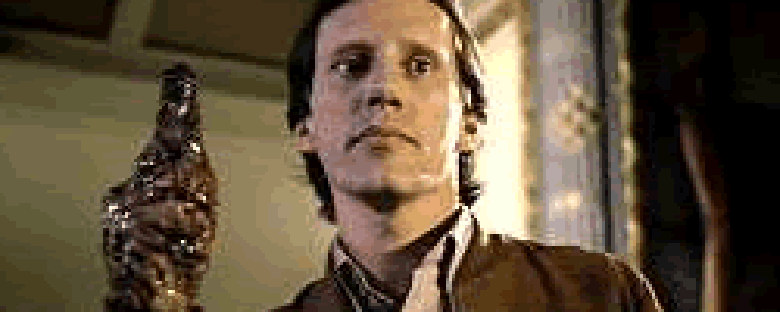Reviews
David Cronenberg’s Videodrome is only superficially about television and its luring power. In a hallucinogenic vision caused by a television program, Max Renn (a cable channel producer) sees his girlfriend’s image on a television screen; she pleads for him to come to her. The set bulges and moans, and Max pushes his head into the screen. The action is obviously sexual.
Max is the producer of Channel 42, a late-night cable channel that specializes in soft-core pornography. Seeking new material to air, Max frequents a video pirate who de-scrambles and tapes broadcasts from airings all over the world. In one session they find a minute-long excerpt from a show entitled “Videodrome”; it displays the torture of a screaming woman by two cloaked individuals. Further tapings yield more of “Videodrome’s” content: rape, murder, and mutilation. Thirsting for risqué material for his cable channel, Max deems the show “Absolutely brilliant.”
Despite the subjective perversity in Max’s statement, there is a redemptive philosophy to his words. For one, his channel is unpopular, and to attract viewers he seeks material that “people can’t get anywhere else.” Channel 42 and “Videodrome,” for the matter, are both outlets for the displacement of violent and/or sexual impulse.
At an appearance on a talk show Max is confronted by the timeless debate of television media as a source of or outlet for violence — if television sex and violence is a means of desensitization or stimulation. Though for this argument the film provides no revelatory defense, it is clear that the debate provides impetus for the film’s philosophic aims; foremost, the content in “Videodrome” airings is purposefully violent, and leads to similar behavior in Max.
Max becomes involved with a radio talk show host Nicki Brand. On a date Nicki finds one of Max’s “Videodrome” bootlegs, and the pair watches. She is curiously aroused by the show, and the two proceed to copulate as it is on. As said before, Max’s exposure to the program causes hallucinations, and in this scene, during their act, Max views his surroundings and finds himself in the “Videodrome” set: it is a dim, unwelcoming red cell; handles and other various attachments are on either side; in front of them is a wetted clay wall with attached electric cables. This is the first — and weakest — of Max’s visions.
Videodrome subscribes to the general tones of science fiction: the genre continually explores a link between technology and the flesh, the inorganic and organic. Note, for example, the purpose of the most perennial character in science fiction — the android. The android represents the cumulative pinnacle of technology; man created by the hand of man. The “Videodrome” program is the adverse conception: the program causes tumors and hallucinations in its viewers. In turn, the machine is revolting against man, and as later actions display, making the animate inanimate.
In this manner Videodrome is the conceptual reversal of the science-fiction android. As Max’s hallucinations continue, he finds that his body engages in metamorphosis. A vagina-like opening appears on his stomach. Max is later “programmed” through the opening with a videotape made of flesh. Max begins to transform into a tape-player; he responds to the programs on the tapes placed inside him and he is made a killer.
In Max’s search for “Videodrome’s” makers he comes upon Brian O’Blivion — whom is never seen in person. Max receives videotapes of O’Blivion; on them, and in a revelatory fashion, O’Blivion claims:
“The battle for the mind of North America will be fought in the video arena — the videodrome. The television screen is the retina of the mind’s eye. Therefore the television screen is part of the physical structure of the brain. Therefore whatever appears on the television screen emerges as raw experience for those who watch it. Therefore television is reality, and reality is less than television.”
In defense of this claim, Brian O’Blivion exists only on television. Max finds he exists as a collection (of thousands) of videotapes. The man inhabits a media, and is real for all intents and purposes within the film’s context.
This detail is keenly mirrored by the presence of Debbie Harry (of Blondie) in the film, as Nicki. The 1982 release of Videodrome coincides with the advent of the music video. In addition to Blondie’s music, Harry appeared on television in the new media (in addition to here, as an actress in a film). Her presence is parallel to Brian O’Blivion’s existence — both are borne of a media.
Although Videodrome is not decidedly a filmic concept, it functions secondarily as such. There is a great irony in the film’s ending that secures its philosophy — that “there is nothing real outside of our perception of reality,” that the images seen on television are perceived as real despite their prospective fiction.
As a parallel, there is a scene midway through Gremlins 2 in which the projector slows, flickers, and stops. The screen is white, the audience looks back, and the silhouettes of the title beasts appear on screen, as if they have attacked the projector and voided the presentation of the film.
Of course, Videodrome is a film and exists (according to its own vocabulary) on videotape. Like the scene in Gremlins 2, Videodrome is perfectly aligned with its presentation. Max’s fate — his reincarnation in the “new flesh” — is invariably linked to the film itself: Max exists as the film.
Videodrome operates as a study in metaphysics; it draws attention to its medium and in doing so cleverly violates its fiction.
We don’t do comments anymore, but you may contact us here or find us on Twitter or Facebook.



